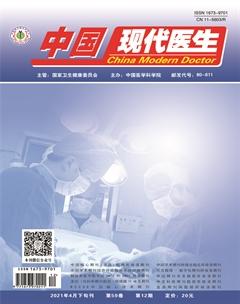5-羥色胺轉運體啟動子區基因多態性與輪班護士睡眠質量的關系
閆盼 王萍 李靜 王晟東 王姝琪 方悅 宋明芬
1.杭州市第七人民醫院? 浙江大學醫學院附屬精神衛生中心分子生物學實驗室,浙江杭州 310013;2.杭州市第七人民醫院? 浙江大學醫學院附屬精神衛生中心精神科,浙江杭州 310013;3.杭州市第七人民醫院? 浙江大學醫學院附屬精神衛生中心檢驗科,浙江杭州 310013
[摘要] 目的 探討5-羥色胺轉運體啟動子區(5-HTTLPR)基因多態性與輪班護士睡眠質量的關系。 方法 選取2018年10月至2019年10月在本院從事輪班制工作的101例護士為研究對象,根據匹茲堡睡眠質量指數量表(PSQI)總分評定睡眠質量,其中睡眠障礙組(>7分)45例,睡眠正常組(≤7分)56例。采集血液,測定5-HTTLPR基因多態性,比較兩組各基因型及各等位基因的頻率分布,分析5-HTTLPR基因多態性與輪班護士睡眠質量的關聯性。 結果 睡眠障礙組輪班護士主觀睡眠質量、入睡時間、睡眠時間、睡眠效率、睡眠障礙、日間功能障礙各因子得分及總分均明顯高于睡眠正常組,差異均有統計學意義(P<0.05);睡眠障礙組與睡眠正常組5-HTTLPR基因型及等位基因頻率分布比較,差異均有統計學意義(P<0.05),其中睡眠障礙組SS基因型和S等位基因頻率分別為64.44%、78.89%,均高于睡眠正常組(41.07%、60.71%),SS基因型者發生睡眠障礙的危險性是LL型的4.623倍(95%CI:1.153~18.542),S等位基因攜帶者發生睡眠障礙的危險性是L等位基因攜帶者的3.929倍(95%CI:1.024~15.065)。 結論 5-HTTLPR基因多態性與輪班護士睡眠質量有關,S等位基因可能是輪班護士發生睡眠障礙的易感基因。
[關鍵詞] 輪班護士;睡眠質量;5-HTTLPR;基因多態性
[中圖分類號] R749.7? ? ? ? ? [文獻標識碼] B? ? ? ? ? [文章編號] 1673-9701(2021)12-0167-04
Relation of gene polymorphisms in the 5-hydroxytryptamine transporter-linked promoter region and sleep quality of nurses taking shifts
YAN Pan1? ?WANG Ping2? ?LI Jing1? ?WANG Shengdong1? ?WANG Shuqi1? ?FANG Yue3? ?SONG Mingfen1
1.Laboratory of Molecular Biology, Hangzhou Seventh People′s Hospital, Affiliated Mental Health Centre, Zhejiang University School of Medicine, Hangzhou? ?310013, China; 2.Department of Psychiatry, Hangzhou Seventh People′s Hospital, Affiliated Mental Health Centre, Zhejiang University School of Medicine, Hangzhou 310013, China; 3.Department of Clinical Laboratory, Hangzhou Seventh People′s Hospital, Affiliated Mental Health Centre, Zhejiang University School of Medicine, Hangzhou? ?310013, China
[Abstract] Objective To explore the relationship between gene polymorphism of 5-hydroxytryptamine transporter-linked promoter region(5-HTTLPR) and the sleep quality of nurses taking shifts. Methods A total of 101 nurses who were working in shifts in our hospital from October 2018 to October 2019 were selected as the study subjects. The total score of the Pittsburgh Sleep Quality Index Scale(PSQI) was used to evaluate sleep quality. Among them, 45 cases were in the sleep disorder group(>7 points) and 56 cases were in the sleep normal group(≤7 points). The blood was collected and the 5-HTTLPR gene polymorphism was determined. The frequency distribution of each genotype and allele was compared between the two groups, and the correlation between 5-HTTLPR gene polymorphism and sleep quality of nurses taking shifts was analyzed. Results The scores of subjective sleep quality, time spent falling into sleep, sleep duration, sleep efficiency, sleep disturbance, and daytime dysfunction and total scores of nurses taking shifts in the sleep disorder group were significantly higher than those in the sleep normal group, and the differences were statistically significant(P<0.05); frequency distribution of 5-HTTLPR genotype and allele were compared between the sleep disorder group and the sleep normal group, and the differences were statistically significant(P<0.05). Among them, the SS genotype and S allele frequencies in the sleep disorder group were 64.44% and 78.89%, which were higher than those in the sleep normal group(41.07% and 60.71%). People with SS genotype were 4.623 times as risky to have sleep disorders as those with LL genotype(95%CI: 1.153-18.542), and carriers of S alleles were 3.929 times as risky to have sleep disorders as carriers of L alleles(95%CI: 1.024-15.065). Conclusion The 5-HTTLPR gene polymorphism is related to the sleep quality of nurses taking shifts. The S allele may be a susceptibility gene for sleep disorders in those nurses.
[Key words] Nurses taking shifts; Sleep quality; 5-HTTLPR; Gene polymorphism
近年來,因睡眠質量問題所帶來的醫療費用增加和工作效率下降已成為社會廣泛關注的公共衛生問題[1]。輪班護士由于工作環境及服務對象特殊,晝夜節律紊亂,其睡眠問題更是不容忽視[2]。以往研究表明,年齡、婚姻狀況、倒夜班年限等可能是影響護士睡眠質量的因素[3],但在這些因素相近的情況下,護士群體中不同個體的睡眠質量也有所差異。近年來,相關研究提示5-羥色胺轉運體啟動子區(Serotonin transporter-linked promoter region,5-HTTLPR)基因多態性與失眠易感性有關[4-5],因此5-HTTLPR基因多態性可能是引起輪班護士睡眠質量個體差異的重要原因,但目前尚無相關報道。故本研究以睡眠障礙的高發人群輪班護士為研究對象,旨在探討5-HTTLPR基因多態性與輪班護士睡眠質量的關系,尋找輪班護士發生睡眠障礙的易感性基因,為睡眠障礙的機制研究提供線索,現報道如下。
1 資料與方法
1.1 一般資料
選取2018年10月至2019年10月在本院從事輪班制工作的護士為研究對象。納入標準:①從事輪班制護理工作至少6個月;②女性;③年齡18~50歲。排除標準:①合并嚴重軀體疾病或精神心理疾病者;②酒精、藥物、濃茶和濃咖啡依賴者;③正在服用治療失眠藥物者;④妊娠或哺乳期婦女。本研究經杭州市第七人民醫院醫學倫理委員會審查通過,所有研究對象簽署知情同意書。
1.2 方法
1.2.1 問卷調查? 自行設計調查表,收集輪班護士的基本信息(性別、年齡、婚姻狀況、文化程度、職稱、輪班年限、夜班頻率等)、生活習慣(吸煙史、飲酒史、體育鍛煉情況等)、疾病情況(各類急慢性軀體疾病)。
1.2.2 睡眠質量評定? 由經培訓的心理測量師使用匹茲堡睡眠質量指數量表(Pittsburgh sleep quality index,PSQI)判定輪班護士的睡眠狀況[6]。該量表由主觀睡眠質量、入睡時間、睡眠時間、睡眠效率、睡眠障礙、催眠藥物、日間功能障礙7個成分構成。每個因子成分按0~4級評定,累積各因子得分為PSQI總分,分值越高說明睡眠質量越差,總分為0~21分,其中≤7分為正常組,>7分為睡眠障礙組。
1.2.3 5-HTTLPR基因型檢測? 所有受試者抽取外周靜脈血2 mL,加入乙二胺四乙酸抗凝,1周內抽提DNA,于-80℃保存待用。通過GenBank查找5-HTTLPR的引物序列,由上海生工生物工程股份有限公司合成,上游引物:5-GGCGTTGCCGCTCTGAATGC-3,下游引物:5-GAGGGACTGAGCTGGACAACCAC-3。PCR反應體系:DNA模板1 μL,上下游引物各1 μL,dNTP 4 μL,2×GC bufffer I 12.5 μL,Taq酶0.25 μL,ddH2O 5.25 μL。PCR反應條件:94℃預變性5 min,94℃變性1 min,62℃退火30 s,72℃延伸1 min,總共35個循環,最后72℃延伸10 min。將上述PCR產物經2.5%瓊脂糖凝膠電泳50 min,在分子成像儀上觀察基因分型,結果判定如下:484 bp條帶為S型等位基因,528 bp或572 bp條帶為L型等位基因;只有484 bp條帶為SS基因型,528 bp或572 bp條帶為LL基因型,484 bp和528 bp或484 bp和572 bp均有者為LS基因型。
1.3 統計學方法
使用SPSS 23.0統計學軟件進行數據分析,計數資料以[n(%)]表示,組間比較采用χ2檢驗。計量資料以(x±s)表示,組間比較采用獨立樣本t檢驗。采用擬合優度χ2檢驗5-HTTLPR基因型分布是否符合Hardy-Weinberg遺傳平衡定律。采用非條件Logistic 回歸計算比值比(OR)及其95%置信區間(95%CI)分析發生睡眠障礙的相對危險度。檢驗標準為雙側檢驗,P<0.05為差異有統計學意義。
2 結果
2.1 兩組一般資料比較
共募集到符合條件的輪班護士101例,其中睡眠障礙組45例(44.6%),睡眠正常組56例(55.4%)。兩組年齡、BMI、婚姻狀況、文化程度、輪班年限、夜班頻次比較,差異均無統計學意義(P>0.05),具有可比性。
2.2 兩組PSQI各因子得分及總分比較
睡眠障礙組輪班護士的PSQI量表各因子得分及總分均明顯高于睡眠正常組,差異均有統計學意義(P<0.05)。見表2。另外,本研究對象均為未使用催眠藥物者,因此,PSQI的催眠藥物因子分均為0。
2.3 兩組5-HTTLPR基因型分布Hardy-Weinberg遺傳平衡檢驗比較
5-HTTLPR基因型頻率進行Hardy-Weinberg遺傳平衡檢驗結果顯示,睡眠障礙組與睡眠正常組觀察值和預期值比較,差異均無統計學意義(P>0.05),提示研究對象來自遺傳平衡群體,有較好的代表性。
2.4 兩組5-HTTLPR基因型及等位基因頻率分布比較
睡眠障礙組與睡眠正常組5-HTTLPR基因型頻率分布比較,睡眠障礙組SS基因型頻率(64.44%)高于睡眠正常組(41.07%),差異有統計學意義(P<0.05);在等位基因分布上,睡眠障礙組S等位基因頻率(78.89%)高于睡眠正常組(60.71%),差異有統計學意義(P<0.05)。Logistic回歸分析結果顯示,以LL基因型為參照,SS基因型輪班護士發生睡眠障礙的危險性是LL型的4.623倍(95%CI:1.153~18.542);以L等位基因為參照,攜帶S等位基因的輪班護士發生睡眠障礙的危險性是L等位基者的3.929倍(95%CI:1.024~15.065)。
3 討論
國內外流行病學調查表明,15%~35%的成年人存在不同程度的睡眠障礙,嚴重影響其腦力和體力的恢復,但其發病機制尚未完全闡明[7-8]。現代醫學將失眠的發生概括為三大因素:易感因素、誘發因素和持續因素[9]。應激性生活事件總是先于失眠出現,因此社會心理應激是失眠的重要原因,但應激事件是否導致失眠,個體間存在顯著差異,可能與個人易感性有關[10]。
以往研究表明,5-羥色胺(5-hydroxytryptamine,5-HT)作為腦內一種重要的單胺類神經遞質,參與睡眠的發生和維持,普遍認為5-HT功能降低是睡眠障礙發生的危險因素[11]。5-HT系統的功能受5-羥色胺轉運體(Serotonin transporter,5-HTT)的調節。5-HTT從突觸間隙中再攝取5-HT決定了突觸后受體介導信號的量和作用持續時間,從而對5-HT能神經傳遞進行精細調控[12]。有研究表明,5-HTT基因多態性可影響5-HTT基因轉錄水平和蛋白表達,進而影響腦組織中5-HT水平[13]。關于5-HTT基因多態性目前研究最多的位點是5基因啟動子區域44 bp的插入/缺失(5-HTTLPR)[14]。5-HTTLPR有長型(L)和短型(S)兩種常見的等位基因,LL、LS、SS三種基因型,其中L等位基因具有較高的轉錄活性,LL基因型比SS基因型個體有更高的mRNA轉錄量和5-HTT蛋白表達量[15-16]。
近年來,相關研究提示5-HTTLPR多態性可能與失眠易感性相關,但仍存在較大爭議。Wankerl等[17]指出攜帶S等位基因的個體較易陷入長時間的警覺和反思狀態,發生失眠的可能性更大。Carskadon等[18]通過開展5-HTTLPR多態性與睡眠模式關系的初步研究后發現,攜帶S等位基因的學生更易持續處于短暫夜間睡眠模式中,而且其睡眠不足容易導致情緒低落。但是,Van等[19]報道稱并未檢測到5-HTTLPR多態性與睡眠質量之間的關聯。筆者分析以往研究結果不一致的原因,可能與研究對象的選擇及存在較多的混雜因素(如性別、年齡、工作壓力、生活習慣等)有關。因此,本研究選擇我院精神科輪班護士這個特殊群體為研究對象來探討5-HTTLPR多態性與睡眠障礙的關系,其優點為其工作環境一致、工作量相似、工作壓力相仿,屬于睡眠障礙的高發人群且睡眠質量有一定個體差異。
有調查顯示,一線臨床護士20%~60%遭受睡眠問題的困擾,主要情況有難以入睡、睡眠淺、易驚醒、醒后不易再入睡、多夢等[20]。在本院調查入組的101名輪班護士中有44.6%發生睡眠障礙,其PSQI各因子得分及總分均明顯高于睡眠正常組,與以往研究結果基本一致。為進一步探討輪班護士發生睡眠障礙的易感基因,本研究比較了睡眠障礙組與睡眠正常組5-HTTLPR基因型和等位基因分布情況,發現睡眠障礙組有較高的SS基因型及S等位基因頻率,SS基因型及S等位基因攜帶者發生睡眠障礙的危險性明顯高于其他類型,提示S等位基因可能是輪班護士發生睡眠障礙的易感基因。
綜上所述,5-HTTLPR基因多態性與輪班護士睡眠質量的關聯性,為合理配置護理人員,改善護士睡眠質量,提高工作效率提供了參考,也為睡眠障礙的機制研究提供了一定線索。但本研究的樣本量較少、研究對象均來自同一所醫院。因此,相關結論仍有待進一步擴大樣本量,開展多中心研究進一步證實。
[參考文獻]
[1] Zhang L,Sun DM,Li CB,et al. Influencing factors for sleep quality among shift-working nurses:A cross-sectional study in China using 3-factor pittsburgh sleep quality index[J]. Asian Nurs Res,2016,10(4):277-282.
[2] Ferri P,Guadi M,Marcheselli L,et al. The impact of shift work on the psychological and physical health of nurses in a general hospital:A comparison between rotating night shifts and day shifts[J]. Risk Manag Healthc Policy,2016(9):203-211.
[3] Lee CY,Chen HC,Meg Tseng MC,et al. The relationships among sleep quality and chronotype,emotional disturbance,and insomnia vulnerability in shift nurses[J]. J Nurs Res,2015,23(3):225-235.
[4] van Dalfsen JH,Markus CR. The serotonin transporter polymorphism(5-HTTLPR) and cortisol stress responsiveness:Preliminary evidence for a modulating role for sleep quality[J]. Stress,2018,21(6):503-510.
[5] Polito L,Davin A,Vaccaro R,et al. Serotonin transporter polymorphism modifies the association between depressive symptoms and sleep onset latency complaint in elderly people:Results from the ′InveCe.Ab′ study[J]. J Sleep Res,2015,24(2):215-222.
[6] 袁雪嬌,宗薇. 精神科護士睡眠狀況調查及影響因素分析[J]. 循證護理,2019,5(7):656-660.
[7] Huang C,Li J,Lu L,et al. Interaction between serotonin transporter gene-linked polymorphic region(5-HTTLPR) and job-related stress in insomnia:A cross-sectional study in Sichuan,China[J]. Sleep Med,2014,15(10):1269-1275.
[8] 賈福軍,李雪麗. 睡眠與睡眠障礙[J]. 中華全科醫師雜志,2016,15(7):215-222.
[9] Dang-Vu TT,Salimi A,Boucetta S,et al. Sleep spindles predict stress-related increases in sleep disturbances[J]. Front Hum Neurosci,2015,9: 68.
[10] van de Laar M,Verbeek I,Pevernagie D,et al. The role of personality traits in insomnia[J]. Sleep Med Rev,2010, 14(1):61-68.
[11] 楊岑,冉明梓,歐陽鵬榮,等. 五羥色胺在睡眠-覺醒中作用[J]. 現代生物醫學進展,2015,15(11):2191-2194.
[12] Knyazev GG,Bazovkina DV,Savostyanov AN,et al. Suppression mediates the effect of 5-HTTLPR by stress interaction on depression[J]. Scand J Psychol,2017,58(5):373-378.
[13] Mendonca MS,Mangiavacchi PM,De Sousa PF,et al. Epigenetic variation at the SLC6A4 gene promoter in mother-child pairs with major depressive disorder[J]. J Affect Disord,2019,245: 716-723.
[14] Nomura M,Kaneko M,Okuma Y,et al. Involvement of serotonin transporter gene polymorphisms(5-HTT) in impulsive behavior in the japanese population[J]. PLoS One,2015,10(3):e0119 743.
[15] Prokofieva M,Karadima G,Koukia E,et al. Association of 5-HTTLPR polymorphism with the nursing diagnoses and the achievement of nursing outcomes in patients with major depression[J]. Issues Ment Health Nurs,2017, 38(10):798-804.
[16] Schneck N,Miller JM,Delorenzo C,et al. Relationship of the serotonin transporter gene promoter polymorphism(5-HTTLPR) genotype and serotonin transporter binding to neural processing of negative emotional stimuli[J]. J Affect Disord,2016,190:494-498.
[17] Wankerl M,Wust S,Otte C. Current developments and controversies:Does the serotonin transporter gene-linked polymorphic region (5-HTTLPR) modulate the association between stress and depression?[J]. Curr Opin Psychiatry,2010,23(6):582-587.
[18] Carskadon MA,Sharkey KM,Knopik VS,et al. Short sleep as an environmental exposure:A preliminary study associating 5-HTTLPR genotype to self-reported sleep duration and depressed mood in first-year university students[J]. Sleep,2012,35(6):791-796.
[19] Van Dalfsen JH,Markus CR. The serotonin transporter 5-HTTLPR polymorphism and the risk for insomnia:A non-replication[J]. Sleep Med,2019,53:195-196.
[20] Dong H,Zhang Q,Sun Z,et al. Sleep disturbances among Chinese clinical nurses in general hospitals and its influencing factors[J]. BMC Psychiatry,2017,17(1):241-249.
(收稿日期:2020-04-09)

